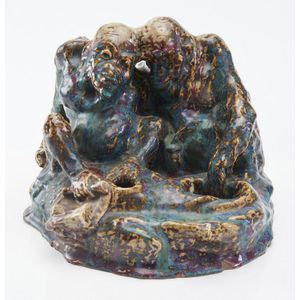Art Nouveau Orangutan Inkwell by Dalpayrat
You must be a subscriber, and be logged in to view price and dealer details.
Subscribe Now to view actual auction price for this item
When you subscribe, you have the option of setting the currency in which to display prices to $Au, $US, $NZ or Stg.
- Attributed - A cataloguing term where the item in the opinion of the cataloguers, is a of the period of the artist, craftsman or designer, and which probably in whole or part is the work of that person.
- Art Nouveau Period - The Art Nouveau period was a cultural movement that emerged in the late 19th century, and was characterized by its emphasis on natural forms, flowing lines, and a decorative, ornamental style. Art Nouveau was a reaction against the ornate and heavily stylized designs of the previous era, and sought to create a new, more organic aesthetic.
Art Nouveau was characterized by its use of sinuous, curving lines, as well as a focus on natural elements such as flowers, vines, and other organic shapes. Art Nouveau designers sought to create a total work of art, in which every element of a building or object was designed to be harmonious with the overall design.
Some of the most iconic examples of Art Nouveau design include the Paris Metro entrances designed by Hector Guimard, the works of the artist Alphonse Mucha, and the architecture of Victor Horta in Brussels.
The Art Nouveau period was at its peak between 1890 and 1910, but began to decline in popularity by the start of World War I. However, Art Nouveau remains an important influence on design and art to this day, and continues to be celebrated for its emphasis on natural forms and decorative style. - Circa - A Latin term meaning 'about', often used in the antique trade to give an approximate date for the piece, usually considered to be five years on either side of the circa year. Thus, circa 1900 means the piece was made about 1900, probably between 1895 and 1905. The expression is sometimes abbreviated to c.1900.
This item has been included into following indexes:
- ink wells / ink stands, French - French 113
- ink wells / ink stands, material
- ink wells / ink stands, period or age - Art Nouveau 25
Visually similar items

Gary Nash blue forget-me-not vase, cylindrical shape, azure blue overlaying mottled blue reef interior visible through the cut-away pattern. Signed and dated '15. Height 22 cm

A French Louis Philippe black marble mantle clock, later 19th century, with a white enamel dial and Roman numerals enclosed in a brass bezel set within a rectangular black plinth with concave edges embellished with mottled red marble and upon a spreading b

A pair of Royal Worcester vases, each blush ivory of globular form with flared pierced top on moulded base, green mark, circa 1888, shape 1079. 25 cm high.

A silver coconut shell dish, silver bowl, carved coconut shell with bamboo and dragonfly motif, base comprising silver frogs on lillypads. Diameter 15.5 cm.
